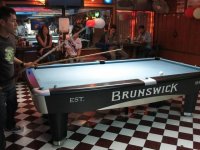I live in Thailand and have seen maybe 100 or so pool table install over the last 10 years.
One of the main install crews here level their slates with a lazer, like this one:
https://www.boschtools.com/us/en/boschtools-ocs/line-lasers-gcl-25-123123-p/

They attach a piece of paper to the side of the bondo can, and this has a horizontal line on it. They then move the can around the slates and adjust/add shims it until the line is in the right place everywhere across the slates.
The tables they install always play well, but I have never gone in with a Starrett level and checked how accurate they are. They mostly install Brunswicks, and have been doing so for over 15 years, so they must be doing something right.
But, when I search on this forum, there doesn't seem to be any mention of this, which seems strange. There must be a reason why the mechanics here don't ever use lazers to level slates - what am I missing?
Thanks in advance,
Tom.
One of the main install crews here level their slates with a lazer, like this one:
https://www.boschtools.com/us/en/boschtools-ocs/line-lasers-gcl-25-123123-p/

They attach a piece of paper to the side of the bondo can, and this has a horizontal line on it. They then move the can around the slates and adjust/add shims it until the line is in the right place everywhere across the slates.
The tables they install always play well, but I have never gone in with a Starrett level and checked how accurate they are. They mostly install Brunswicks, and have been doing so for over 15 years, so they must be doing something right.
But, when I search on this forum, there doesn't seem to be any mention of this, which seems strange. There must be a reason why the mechanics here don't ever use lazers to level slates - what am I missing?
Thanks in advance,
Tom.
